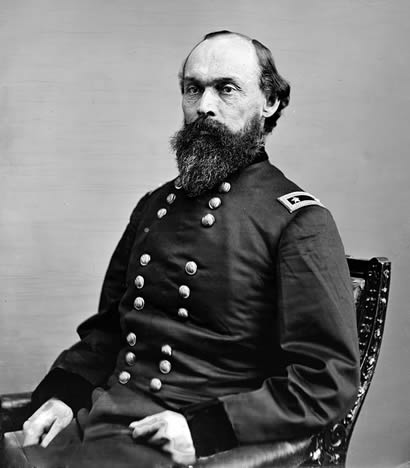|
At
the end of the Civil War and nine days after he was given command
of the Department of Texas on June 10, 1865, Union General Gordon
Granger made a trip to Galveston
and on June 19, 1865, he declared that all slaves in Texas were free.
It had taken more than two and a half years since President Abraham
Lincoln issued his Emancipation Proclamation for slaves in Texas to
actually know freedom.
Officially, it went down in the books as "General Order Number 3,"
- that order immediately declared freedom for over 250,000 slaves
in Texas. It said there would no longer be a relationship between
master and slave but from that historic moment on it would be considered
a relationship between employer and hired labor.
Gen. Granger's trip to Galveston
would only be the beginning of a slow process that would see him traveling
throughout Texas for the next six weeks. His hopes were that the word
would spread from plantation to plantation until it was known all
across the state that slavery was officially abolished. But it wouldn't
be until the end of summer 1865, that the abolishment of slavery was
known throughout Texas. |
 |
Union General
Gordon Granger
Library of Congress photo |
It's impossible
to know what went through the minds of those enslaved people, laboring
in the cotton fields, when they heard the news of their newly acquired
freedom. No doubt there was a lot of disbelief.
From the piney woods of East
Texas to the hill
country, there were many reports that freed slaves didn't know
what to do or where they should go. Many moved to the northern states
but some stayed near what had been home to them for many years.
According to the Texas General Land Office, although slavery was illegal
under Mexican law, slaves were still brought into Texas by immigrants
from the United States. And as the years went by, the number of those
enslaved would reach a number of nearly 300,000.
The day of declared liberty for African-American Texans became known
as "Juneteenth" and has been celebrated for over 150 years by freedom-loving
people of all races. The historic day has evolved over the years to
become an icon in the struggle for civil rights.
Juneteenth and its profound meaning of equal rights have continued
to advance from that historic day in 1865. A bill was introduced by
Rep. Al Edwards of Houston
in 1979 calling for Juneteenth to become a state holiday. The state
legislature passed the bill and it was signed into law by Governor
William P. Clements Jr.
According to The Handbook of Texas Online, the first state-sponsored
celebration took place in 1980. Juneteenth and its concept of freedom
are not limited to Texas alone, cities across the United States celebrate
the day as well. Minneapolis and Milwaukee are known to have large
celebrations.
People who have moved out of Texas still celebrate Juneteenth in their
new locations. Some who have moved to Louisiana and Oklahoma remember
the significance of the date and still honor it. The day was recognized
in 1991 in Washington D.C. when the Anacostia Museum of the Smithsonian
Institute sponsored an event called "Freedom Revisited." It included
African-American arts and crafts along with speakers and other programs.
Finally, after much effort, people like 93-year-old Opal Lee, a retired
educator from Fort Worth,
have seen their dream to make Juneteenth a national holiday come true.
Lee worked for over forty years to acquire one million signatures
and she saw her project come to fruition when President Joe Biden
signed into law a bill creating Juneteenth National Independence Day
on June 17, 2021. Opal Lee was at that event.
The City of Galveston celebrated the new federal law with much enthusiasm
- not unlike the day that liberty for African-Americans was declared
by an official of the United States government over 150 years ago.
Among the many speeches by local officials and other activities, including
fireworks and the Juneteenth parade, the dedication of the "Absolute
Equality" mural by the artist Reginald C. Adams of Houston was held.
The mural's title is actually from words contained in General Order
Number 3 - the historic sheet of paper that finally gave enslaved
and oppressed people their freedom at last. |
Related Articles:
- Juneteenth
by Archie P. McDonald
- Slaves
by Mike Cox
A better way to comprehend slavery is to read some of the official
paperwork filed away in the courthouses of Texas counties that
existed before the Civil War and the freedom for blacks that followed
in 1865.
- Sam
Houston's trusted friend was born a slave by Murray Montgomery
The man who was born into slavery and went on to become a trusted
friend of Sam Houston died in Belton on April 3, 1941. He is honored
by two Texas historical markers...
- Slave
Ada Stone by Murray Montgomery
109-Year-Old Ex-Slave Recalls Days Long Past
- Former
slave recalls memories of old Lavaca County by Murray Montgomery
In 1946, a black man by the name of Tate Hicks told a local paper
that he was the oldest man in Lavaca County. Fact is, he came
to Texas as a slave...
- Birthday
Cake with 111 Candles washed down with "Good" whiskey by Mike
Cox
Sullivan claimed his mother had been one of George Washington’s
slaves. Eventually freed by the first president, Sullivan’s mother
married a man named Sullivan and had several children. Though
free, her children ended up being pressed back into slavery, literally
“sold down the river” from Kentucky to Mississippi.
More Texas
Black History
|
|
|
